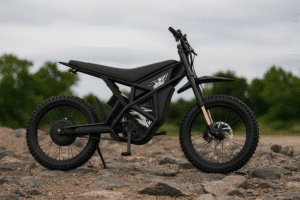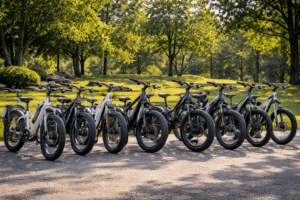A well-built electric bike can last 5 to 10 years, or even longer, depending on how often you ride, how well you take care of it, and what components it uses.
Most riders will need to replace the battery every 3 to 7 years, while motors usually last a bit longer. Frames can last decades if they’re not damaged, but smaller parts like chains, tires, and brake pads wear out much faster.
This article breaks down the lifespan of each major part of your e-bike and helps you understand what really limits how long an e-bike can last with regular use and maintenance.
Key Takeaways:
- Most e-bikes last 5 to 10 years with proper care and maintenance.
- Batteries typically need replacing every 3 to 7 years due to charge cycle limits.
- Mid-drive motors usually last longer and are easier to service than hub motors.
- Frames can last decades if not damaged or exposed to corrosion.
- Regular tune-ups, smart storage, and good riding habits extend your e-bike’s lifespan.
- Choosing a reputable brand with long-term parts support makes future repairs easier.
How Long Do E-Bikes Last?
Most e-bikes last between 5 and 10 years, depending on how often they’re used, how well they’re maintained, and what parts they’re built with.
The frame can last much longer, sometimes decades, while components like the battery and motor have shorter lifespans.
Batteries typically last 500 to 1,000 charge cycles, or about 3 to 7 years for most riders. Motors can go 10,000 to 20,000 miles with proper use.
The key to longevity is regular maintenance and replacing worn parts before they cause bigger issues. With care and a little planning, an electric bike can be a reliable ride for many years.
What Factors Affect E-Bike Lifespan?
Several key factors determine how long an electric bike will last, and most of them come down to how it’s built, how it’s used, and how it’s maintained.
- Battery quality and charge cycles: Most last 500 to 1,000 full cycles with proper care.
- Motor type and usage: Mid-drive motors tend to last longer than hub motors.
- Frame material and durability: Aluminum resists rust; steel handles stress well.
- Weather exposure and storage: Moisture and extreme temps can shorten component life.
- Maintenance habits: Routine care prevents small problems from turning into major failures.
- Parts availability: Bikes with proprietary or discontinued parts are harder to keep running long-term.
- How and where you ride: Heavy loads, steep hills, and rough terrain increase wear and tear.
What Does “Lifespan” Really Mean for an E-Bike?

An e-bike’s lifespan depends on its parts. Batteries, motors, and components will eventually wear out, but the frame can often last decades with proper care.
So when someone asks how long an electric bike lasts, the real answer is: it depends on which part you’re talking about. Most modern e-bikes are made with replaceable parts.
If you’re willing to repair or upgrade components over time, there’s not much stopping a good e-bike from running well past the 10-year mark. That said, some parts age faster than others, and how you ride and store your bike matters a lot.
The battery is usually the first thing to wear out. Motors come next, followed by drivetrain parts like chains and cassettes. But most of these can be replaced.
What often “kills” an e-bike isn’t just wear and tear — it’s when replacement parts are no longer available or repairs cost more than the bike is worth.
If you stick with brands that support their bikes long-term and you stay on top of basic care, your e-bike could last far longer than most people expect.
Battery Life: The Limiting Factor for Most Riders
Most e-bike batteries last between 500 and 1,000 full charge cycles, which usually means about 3 to 7 years of regular use.
Battery lifespan depends on how often you ride, how you charge it, and what kind of terrain you cover. Steep hills, heavy loads, and extreme weather can wear out a battery faster. On average, riders can expect somewhere between 12,000 to 35,000 miles before the battery capacity drops significantly.
One issue with e-bike batteries is that they’re not all created equal. Some bikes use common battery standards, while others are locked into proprietary systems. That matters when it’s time for a replacement, especially if the brand goes out of business or stops making that model.
Charging habits also play a big role. Keeping your battery between 20% and 80% charged, avoiding deep discharges, and storing it in a cool, dry place can help extend its life.
But eventually, even the best battery will need replacing, and that’s usually the first major cost in long-term e-bike ownership.
E-Bike Motor Durability: Mid-Drive vs Hub Motor Lifespan
A good e-bike motor will typically last 5 to 10 years, depending on the type and how you ride.
Mid-drive motors tend to last longer and perform better under load, especially on hills or when carrying weight. That’s because they work with your bike’s gears, reducing strain and keeping things efficient. Hub motors, which are sealed in the wheel, are simpler and often cheaper but can be harder to service if they fail.
Motor lifespan isn’t just about hours of use; it’s also about heat, stress, and how well it’s protected from dirt and water.
Most quality motors from brands like Bosch or Shimano can go tens of thousands of miles with only minor issues. But when something does go wrong, mid-drive motors are often easier to service or replace than hub motors.
If you ride often and plan to keep your bike for years, investing in a motor that’s known for long-term reliability, and from a brand with good support, makes a big difference.
How Long Do E-Bike Frames Last?
A quality e-bike frame can easily last 10 to 20 years or more, assuming it’s not damaged or corroded.
Unlike batteries and motors, the frame doesn’t have moving parts that wear out. Most modern frames are made from aluminum or steel.
Aluminum is lighter and won’t rust, but it can develop fatigue cracks over time. Steel is heavier and can rust if not protected, but it generally holds up better to long-term stress and is easier to repair if it cracks.
Frame longevity also depends on how the bike is used and stored. Riders in snowy or coastal areas should be extra cautious about corrosion, especially if road salt or humidity is a factor.
Keeping the frame clean, dry, and properly coated can make it last decades, long after other parts have been replaced multiple times.
What Parts Will You Replace Over Time?
Most e-bike riders will end up replacing a few key parts regularly. These aren’t signs of failure — just normal wear from riding.
Here are the most common parts you’ll need to replace:
- Battery: Every 3–7 years, depending on usage and quality.
- Brake pads: Every 1,000–2,000 miles, or more often with heavy braking.
- Tires: Every 2,000–5,000 miles depending on terrain and tire type.
- Chain and cassette: Roughly every 1,000–3,000 miles, especially with mid-drives.
- Controller/display: May last 3–6 years but can fail sooner due to electronics.
- Grips, cables, and other minor parts: As needed with age and wear.
Regular tune-ups can help catch small issues before they turn into expensive repairs. Think of it like keeping your car running, it’s all about staying ahead of wear and tear.
What Can “Total” an E-Bike?
An e-bike is considered “totaled” when the cost to repair it is higher than what it’s worth. This usually happens when key parts like the battery, motor, or controller fail and can’t be replaced affordably.
Accidents, water damage, and battery fires are the most common reasons an e-bike becomes unrepairable. Frames can crack, electronics can short out, and sometimes even small parts are impossible to find, especially if the bike uses a proprietary system or comes from a brand that’s no longer around.
Another overlooked factor is long-term parts availability. If you can’t get a replacement battery or motor because the company discontinued them, your bike might be fully functional today but useless tomorrow.
That’s why it’s worth thinking about support and service when choosing a bike, not just features or price.
Can an E-Bike Last 100,000 Miles?
Yes, an e-bike can technically last 100,000 miles, but only if every major component is replaced over time. To get there, you’d likely go through multiple batteries, motors, chains, wheels, and more, just like rebuilding a car from the ground up.
The only thing that might remain original is the frame, and even that would need to be in good shape. It’s possible, but not typical, and it takes dedication, mechanical knowledge, and regular maintenance.
What to Look for When Buying a Long-Lasting E-Bike
If long-term reliability is your goal, it’s important to choose the right bike from the start. Some models are made to last, while others are hard to maintain or upgrade.
Here’s what to focus on:
- Reputable motor and battery systems: Stick with known names. They offer long-term support and service options.
- Standard, serviceable parts: Avoid bikes with fully proprietary parts. Look for bikes that use common standards for tires, chains, brakes, and drivetrains.
- Frame material and build quality: Aluminum and steel frames are durable if well-maintained. Look for certifications like ISO 4210 or DIN 79010 for added assurance.
- Battery replacement availability: Make sure the brand supports battery replacements long after the model is discontinued. This is often where bikes become unrepairable.
- Local service access: Some brands offer certified service centers or work closely with local bike shops. That makes tune-ups and diagnostics much easier.
- Good warranty coverage: Look for warranties of at least 2 years on electronics and up to 10 years on the frame if possible.
Final Words
A good electric bike can easily last 5 to 10 years or more if you maintain it well and replace key components when needed.
The battery will likely be the first thing to go, followed by the motor and wear-and-tear parts like chains and brakes. But the frame? That could outlast everything if you take care of it.
If you’re choosing an e-bike for the long haul, go with a well-known brand that uses standard parts and supports repairs. The more serviceable your bike is, the easier it will be to keep it rolling for thousands of miles to come.
FAQs
How many years can I expect from an e-bike?
Most e-bikes last between 5 and 10 years with regular use and maintenance. The frame can last longer, but parts like the battery and motor will need replacing over time.
Can I replace the battery or motor?
Yes, most e-bikes allow battery and motor replacements. However, availability depends on the brand and model. Choosing a bike with a well-supported system makes replacements easier.
What if parts are no longer available?
If key parts like the battery or motor are no longer available, your e-bike may be difficult or impossible to repair. That’s why it’s smart to buy from brands that commit to long-term parts support.
How does weight or terrain affect lifespan?
Heavy loads, steep hills, and rough terrain put more strain on your bike’s motor, battery, and frame. This can lead to faster wear, especially if the bike isn’t built for that kind of use.
Is it cheaper to replace or repair an e-bike?
It depends on the damage. Replacing small parts like brakes or chains is cheap. But if the motor or battery fails and replacements are expensive or unavailable, buying a new e-bike may be more cost-effective.
Al Amin Morshed is the founder of BoltBikers and a seasoned e-bike reviewer with years of hands-on experience testing electric bikes. As a long-time e-bike enthusiast, he combines real-world riding insights with in-depth research to create honest, helpful content for riders of all levels. Through BoltBikers, Morshed aims to make e-biking more accessible, practical, and enjoyable – whether you’re a new rider or a daily commuter looking for the best gear.








